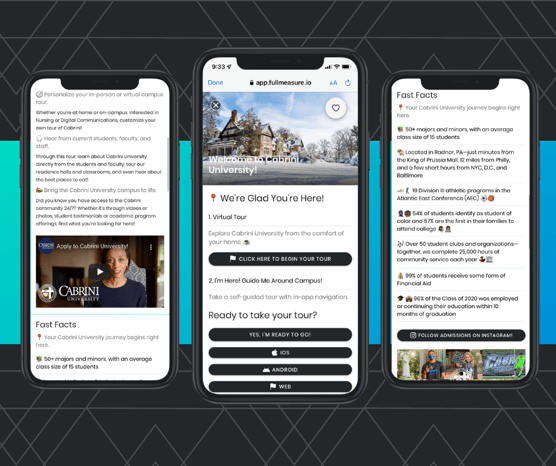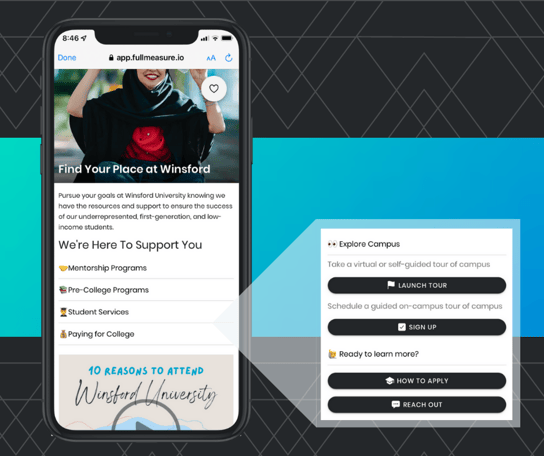4 ideas for enhancing tour communications to increase engagement, inspire participation, and drive application volume and enrollment. Plus, a fool-proof strategy for quickly scaling your process.
By: Kyle Freelander
If you had to guess what makes a successful tour experience, you'd probably only think about the tour content itself.
While that’s undoubtedly important (learn more on how to ensure relevant and impactful tours here), there’s something even more foundational that will help capture wider engagement and ensure every prospective student gets to see what makes your institution unique: Your communication strategy.
Naturally, institutions should advertise their tour offerings in high-traffic areas (websites, direct mail, social media, etc.), but these can’t be your sole method for getting the word out — especially if you’re looking to reach and engage with a different or larger audience in a meaningful way. To yield new results, you need a mobile-first engagement strategy.
Research shows 98 percent of SMS messages get opened (compared to 20% of emails) and more than half (58.7%) of people check texts within 5 minutes of receiving them.
And it’s not just about inviting students to take a tour. You should be engaging students before and after their tour to continuously foster excitement. Think about sending relevant and customized follow-up communications to students after they tour to learn about their experience and ask for feedback. You should also consider engaging families and other supporters who can play key roles in helping students decide where to apply and ultimately attend.
In addition to helping institutions design impactful tours and enable personalized visits, StudentBridge’s Campus Visit Experience helps amplify institutions’ communications strategy with a customizable mobile-first approach. Easily design curated content cards for a variety of audiences (prospective first-year students, transfer students, families, etc.) before, during, and after tour experiences.
With this in mind, we wanted to share 4 easy ways to enhance your campus visit communications to increase engagement, inspire participation, and drive application volume, enrollment, and matriculation. We’ll also show some examples of how our institutional partners are already creating tailored messages for a varied number of unique audiences using the Campus Visit Experience.
1. Invite prospective students to take a tour whenever their schedules permit
Travel costs. Conflicting schedules. Tour time slots. Health and safety concerns. These are just a few obstacles students face when it comes to visiting campus and completing an in-person tour. For some, it may mean not being able to take a tour ahead of applying or deciding on what institution to attend.
Of students who graduated high school in 2021 and took the ACT, 20 percent said they did not visit a college campus but had planned to before the pandemic, and 13 percent said they had no plans to visit a college campus.
By sending a custom content card directly to students who’ve expressed interest online, you can make sure they know all the ways they can tour campus — whether that's through a virtual tour, in-person tour, zoom tour, or upcoming admissions event. On this card, you can also surface key information (like what makes your institution special), include a pulse survey to help you understand if a student needs more support or information, and let them know how they can ask additional questions.
For those using the Campus Visit Experience, this is also a prime opportunity to let students know how they can fully personalize their tour experience based on their individual interests and needs.

2. Invite families and other supporters to tour as well
Often when we think about who should take tours, prospective students are top of mind. However, engaging family members and other supporters is just as important. They play a key role in helping students decide where to apply and attend, with research showing 61 percent of students said their parents were the most important influencer in their enrollment decision.
The Campus Visit Experience enables students to easily share relevant content directly with their family, friends, and other supporters. With a simple tap, students can text a curated card to whomever, inviting them to learn more about the institution. This is a great opportunity to invite supporters to take a virtual or self-guided tour — whether it's a general campus tour, whichever tour their student has already taken, or a tour designed specifically for family and friends.
3. Get more out of your events
Events are a powerful and exciting way for students to explore campus and get to know your institution. Use content cards to help inform students about upcoming events, drive students to take the next steps afterward, and enhance the event itself.
Increase excitement for and participation in upcoming visit events
Help event organizers reach and engage prospective students ahead of key events, such as open houses, college fairs, and orientation. Share event logistics (such as date and time, where to meet, and options for virtual participation) and emphasize what makes the event special.
Make next steps happen with follow-up communications
Don’t leave what happens after the event up to chance. Engage with prospective students and their families post-event to highlight next steps, gauge where they’re at in their decision-making process, and identify opportunities to provide more information and support.
Bring visit events to life
Content cards can also be part of your event. Take, for example, Family Weekend. You can share a content card with families inviting them to take a self-guided tour during their visit or sign up for a guided tour. This is also a great opportunity to expand your curated tour offerings (think: visit the new athletics facility or theater) or unexpected fun tours like visiting the downtown area or a top 10 places for parents to see experience. The possibilities are endless, and the fun is just beginning.
%20(2).png?width=566&name=CVE%20blog%20post%20-%20welcome%20back%20spring%20(cards)%20(2).png)
4. Continue engaging prospective students after the tour is over
Don’t stop engaging with students once the tour is over. This is the time to provide additional information based on their interests and needs, highlight any next steps, and answer questions that may arise.
Because the Campus Visit Experience enables students to personalize their tours based on demographics, individual interests, and more, it’s easier than ever to ensure relevant follow-up communications. For example, if you know a prospective student is a first-generation college student, you can surface important resources and provide additional support. You can also create campaigns specific to transfer students, adult learners, student-athletes, and more.

Kyle Freelander (she/her/hers) is a passionate writer, former educator, and lifelong learner. She has taught English literature and writing courses in higher education, writing workshops in K-12 schools, and English and ESOL courses as a private tutor for students pre-K and up. She holds an MFA in Creative Writing from George Mason University and a BA in English (minor in Linguistics) from the University of Mary Washington. She currently serves as the Head of Content at StudentBridge.

